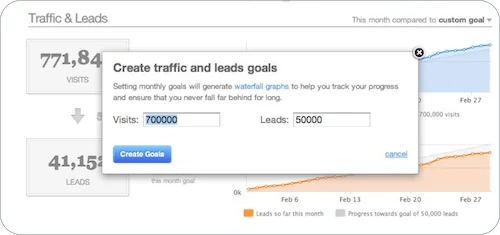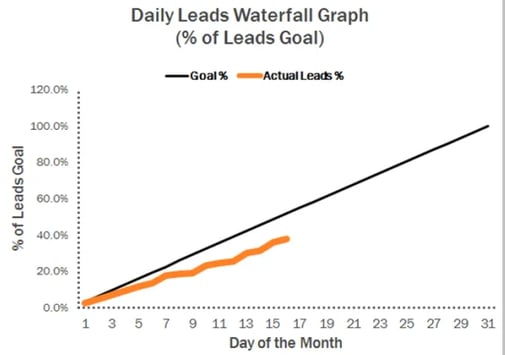As inbound marketers, we all know the value and importance of measuring, tracking, and reporting on key metrics and goals. Let's take the data you collect around your lead generation efforts, for instance.
If you know what your marketing team can generate for new leads, and you also know your average lead-to-customer conversion rate, your business can actually predict future sales!
And with closed-loop marketing in place, you can even track the revenue generated from the leads that were influenced by various channels or marketing events.
That's a lot of meaty data, but how do you take that information and apply it to setting a lead generation goal that helps you meet your business objectives? Your effectiveness as a lead generator hinges on your ability to generate both the right amount , and the right type of leads. Establishing the right balance for your business is crucial, but tricky -- luckily this post will explain exactly how you can do it! Here are 4 simple steps to set effective lead generation goals for your marketing team.
Step 1: Determine if you want to measure quantity, quality, or both.
The first step to setting goals for your marketing team is to figure out what you want to measure -- remember, you can't determine whether you met your goals if you aren't measuring them! Most marketers have traditionally measured themselves on the quantity of leads they produce each month or quarter. This is easy to do if you have inbound marketing software, which allows marketers to track their lead generation progress across every campaign. For example, in HubSpot's software, all you have to do is input your lead generation goal, and easily track the number of leads you generate each day, week, month, or year!

If you’ve been tracking lead volume for quite some time and feel that it’s almost impossible to increase your lead goal month over month, however, then it might be time to measure lead quality . Sometimes we’re so focused on how many leads we can generate that we forget the underlying motivation for our lead generation goals -- to generate revenue through new customers. This requires Marketing to generate new leads, and more importantly, nurture the existing leads in their database to convert them into customers.
One way to do this is to measure your marketing efforts not just by the number of net new leads, but also by the number of high quality, sales-ready leads. For example, if your lead volume has historically been 10,000 leads per month, you may decrease this overall goal to 5,000 leads per month, and create an additional quality leads goal of 500 leads per month. If the conversion rate of your regular leads is 1% and the conversion rate of your quality leads is 10%, then you’ll yield the same number of new customers, but with more efficiency.
To measure lead quality, first determine what an MQL, or marketing qualified lead, is for your business. An MQL is a lead that is more likely to convert into a customer depending on certain behaviors that the lead exhibits on your website. Once you determine what these behaviors are, then you can start measuring the number of leads you generate that match these behaviors.
Step 2: Set lead generation goals based on larger business goals.
After you’ve determined what you will measure, your next step is to create and set a goal for your team. The most important factor to consider when setting your new lead generation goal is how it aligns with your overall business goals. First, meet with the management team at your company to determine your business' growth projections so you can understand how Marketing fits into this bigger picture. So if your company is looking to grow by 5% in revenue in the following quarter, you’ll need to figure out how many leads or MQLs you’ll need to generate in order to close 5% more customers or revenue.
In order to determine how many leads you’ll need to produce to meet an increase in revenue goals, you’ll need to know the average sale price and close rates of your leads. Let’s say you need to generate $10,000 more in revenue , the average sale price of your product is $1,000 , and the average close rate of your leads is 5% . This means that each lead you generate is worth $50 (ASP x avg. close rate). So in order to generate $10,000 in revenue, you’ll need to generate 200 more leads (revenue goal/value of a lead) to reach your goal.
Other factors to consider should be the past ability of your team to execute on your new goal. Take a look at historical lead volume to see if your new goals are in fact achievable. If over time, you see a fluctuation in your lead volume, think about what helped you reach new heights; was it an increase in budget? Did you start creating more content during those high points? Did you bring on some new hires that contributed to lead generation? Determine what influenced the trends in your lead flow so you can plan to meet your new goal. You should also consider additional changes, upcoming campaigns, and other ongoing projects that may directly influence lead volume, and create a new goal that’s attainable given the circumstances.
Step 3: Communicate your new goal, and motivate the team to reach it.
Once you’ve settled on a new lead generation goal, it’s important to communicate it effectively and figure out how to best motivate the team to reach it -- this should come from the head of the Marketing department, or if you're a small company, the CEO. Make sure he or she explains the business reasons for the new goal and the positive impact this change will have. For example, if you are switching your goal to decrease overall lead volume but generate more MQLs, the motivation behind this may be to leverage your existing leads database and make Sales more efficient, spending more time on closing deals and less time prospecting for good fits. Now the entire marketing team understands the larger business reasons for changing your goal.
Depending on the size of your marketing department, each individual or sub-team should also have its own lead generation goals that contribute to the larger marketing goal. Giving each team ownership over an individual lead goal motivates them to perform and execute, especially since they know how it will influence a larger shift in the business. Actively encourage teams to experiment and try out creative ideas to achieve their goals; it can also be advantageous to forewarn teams of an impending new goal so they can take the time to experiment before it really counts. During experimentation, be sure to measure lead volume, conversion rates, and close rates to see how it compares to the status quo.
Step 4: Track and measure progress against your goal.
The last and most important step when setting a new goal is tracking and measuring the progress. You should be measuring your progress on a daily basis and tracking it against a daily goal to ensure that you’ll hit your monthly goal -- if you're down one day, you can act fast tomorrow to make up for the leads you didn't generate and get back on track. The easiest way to do this is through a daily waterfall report like the one you see here.

The waterfall report shows your daily progress against your goal over the period of time you set, though it's typically a month. This blog post will give you step-by-step instructions on how to create a waterfall report for your team (and if you use HubSpot, the software will create one automatically using the goal you inputted in step 1!). The waterfall should be shared with the Marketing and Sales team on a regular basis, and analyzed for what causes spikes or dips along the way.
Do you measure lead quantity, quality, or both? What influenced your decision?
Image credit: cdsessums
Lead Generation
.png?width=112&height=112&name=shortening-property-en%20(1).png)



![What is a lead magnet? 20 lead magnet ideas and examples [+ step-by-step]](https://53.fs1.hubspotusercontent-na1.net/hubfs/53/lead%20magnet%20represented%20by%20a%20magnet.webp)




![Gated Content: What Marketers Need to Know [+ Examples]](https://53.fs1.hubspotusercontent-na1.net/hubfs/53/UNGated%20Content.png)

![What Is Demand Generation? Here’s How You Can Create Buzz for Your Offering [FAQs]](https://53.fs1.hubspotusercontent-na1.net/hubfs/53/demand-generation-1-20250321-225687.webp)

